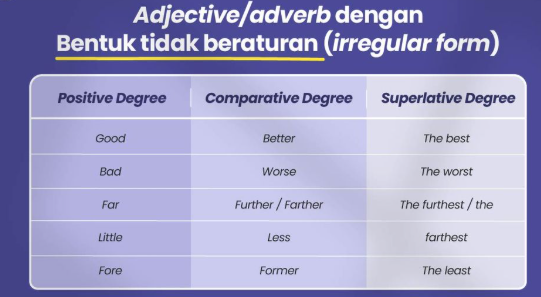Comparison Degree: Definition, Patterns & Example Sentences
Have you ever seen a selfie post on social media, and someone commented ,
“ You are so pretty !”
Then the post owner answered the comment with,
” Aww, thank you, but you are actually prettier than me !”
Getting that answer, the commentator replied,
” Nooo, what are you darling? You are prettier than me !”
Eh, the owner of the post is still insistent,
“ Nooo, you are prettier! ”
Just keep going like that for the next year.
Hmmm.. sometimes I get annoyed when I find something like that.
I feel really itchy to join in the comments ,
“How long is this going to go on, replying to comments about who is prettier?”
Hey, did you guys know? Even though it’s annoying, there’s still something to be learned from those comments !
Huh, seriously? Really?
Oh, of course! Let’s take a closer look at those comments, folks . You can see they’re comparing who’s prettier. In English, something that shows a comparison is called a Comparison Degree or Degree of Comparison .
Wow, what is a Comparison Degree ? Let’s find out!
Understanding Comparison Degree
Degree of Comparison , or also called Comparison Degree, is a term in English grammar to indicate comparison .
In the Comparative Degree , adjectives or adverbs will change form according to their level of comparison. Therefore, the Comparative Degree can also be called a Level of Comparison.
Comparison Degree Function
Comparison Degree is used when you want to compare one thing with another .
Comparison Degree Levels
The degree of comparison has three levels: positive degree , comparative degree , and superlative degree . What’s the difference between them? Let’s take a look at the following image!

Comparison Degree Sentence Patterns and Examples
Now that you know the differences and patterns between the three, it’s time to learn example sentences using the comparative degree . Let’s discuss them one by one!
1. Positive Degree
In the positive degree , the two things being compared are on the same level or comparable, therefore it is used as an adjective/adverb as . For example, ” You are as pretty as her .” means you are as beautiful as her.
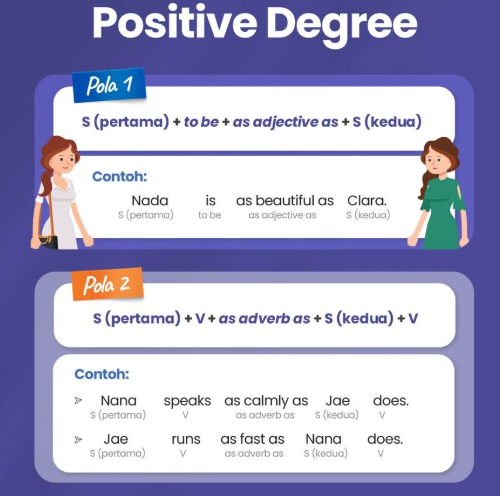
2. Comparative Degree
In the comparative degree , one of the two things being compared has a ‘greater’ quality than the other, therefore the adjective/adverb + -er or more + adjective/adverb is used . For example, ” You are prettier than her .” means you are prettier than her.

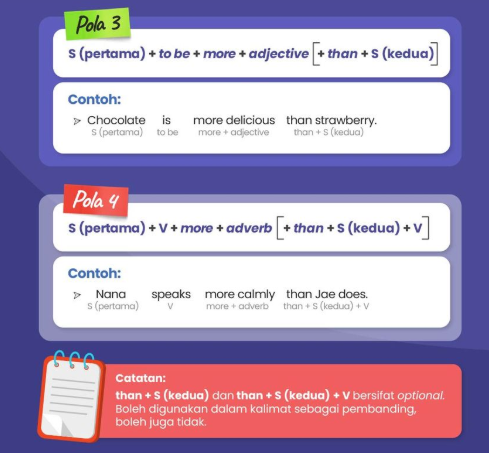
3. Superlative Degree
In the superlative degree , the thing being discussed has the quality of being the ‘most’ among others, therefore the adjective/adverb + -est or most + adjective/adverb is used . For example, ” You are the prettiest girl in school .” means you are the most beautiful girl in school.
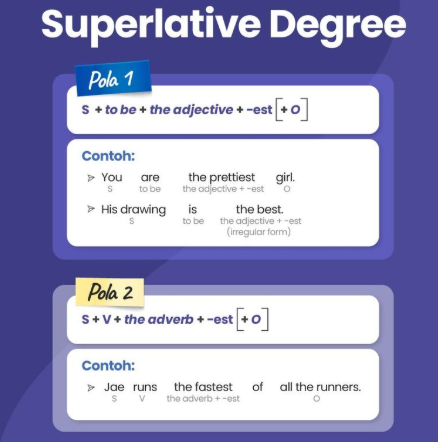
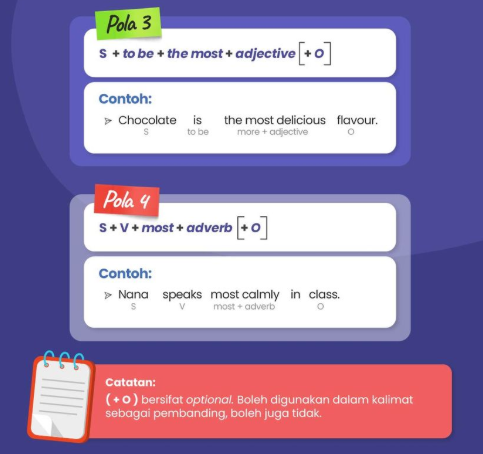
So, usually, after knowing the patterns and examples of Comparison Degree sentences, friends will definitely ask the questions below:
“ When should you use -er/-est and when should you use more/most ?”
Come here, come closer. I’ll whisper the answer!
The use of -er/-est or more/most must be adjusted to the adjective/adverb used in the sentence.
Rules in Comparison Degree
There are several rules that friends should know, including:
Adjective/Adverb with 1 Syllable
The meaning of 1 syllable is that the adjective/adverb cannot be separated, so it is only pronounced once.
Example:
- Cheap is pronounced as /chip/ , not /chi-ep/
- Large is pronounced as /larj/ , not /lar-je/
Adjectives/adverbs with 1 syllable always use -er/-est .
But if the adjective/adverb ends in a consonant preceded by 1 vowel , then the last consonant must be written double .
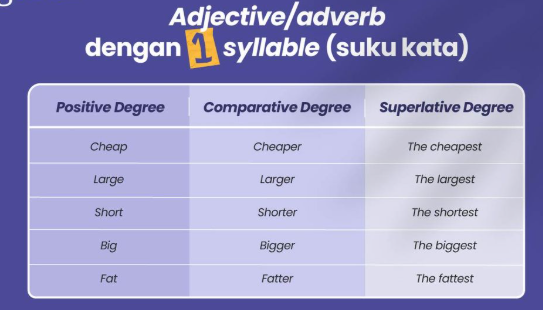
Big changes its form to bigger and biggest , not biger and bigest , because big ends with the consonant g preceded by the vowel i , so the last consonant must be written double .
Meanwhile, cheap is written as cheaper and cheapest , not cheapper and cheappest , because cheap ends with the consonant p but is preceded by 2 vowels, namely e and a , so the last consonant does not need to be written double .
Adjective/Adverb with 2 Syllables
The meaning of 2 syllables is that the adjective/adverb can be divided into 2 parts, so that the pronunciation consists of 2 words.
Example:
- Happy is pronounced as /hep-pi/
- Clever is pronounced as /kle-ver/
Adjectives/adverbs with 2 syllables can use -er/-est , or more/most .
Adjectives/adverbs with 2 syllables that use -er/-est have the following characteristics:
- Ending in -er , -le , -ow , examples: clever, simple, shallow
- Ends in -y , but y changes form to i, for example: happy becomes happier and happiest
Adjectives/adverbs with 2 syllables that use more/most have the following characteristics:
- Ending in -ly , -ful , -less , -ing , -ed , -ous , examples: calmly, painful, hopeless, boring, worried, famous
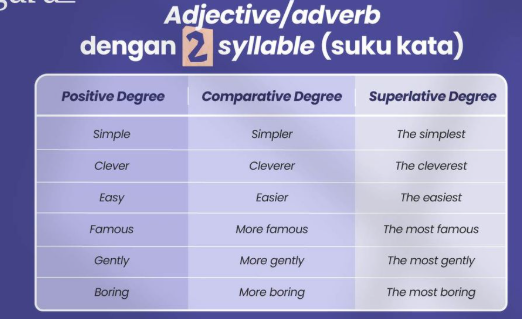
Adjective/Adverb with 3 or more Syllables
The meaning of 3 or more syllables is that the adjective/adverb can be divided into 3 or more, so that the pronunciation consists of 3 or more words.
Example:
- Expensive is pronounced as /eks-pen-siv/
- Comfortable is pronounced as /kam-fer-te-bel/
An adjective/adverb with 3 or more syllables always uses more/most .
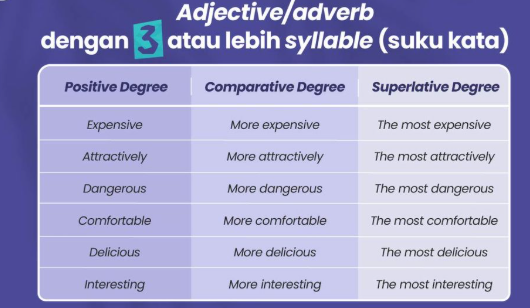
Adjectives/Adverbs with Irregular Forms
Irregular adjectives/adverbs ( irregular forms ) do not follow the rules for adding -er/-est or more/most , because they are already like that from the start.
